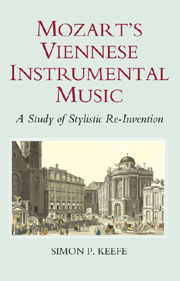Book contents
- Frontmatter
- Contents
- List of Musical Examples
- List of Figures
- For Celia, Abraham and Madeleine
- Acknowledgements
- Introduction: Mozart and Stylistic Re-Invention
- I PIANO CONCERTOS
- 1 ‘An Entirely Special Manner’: Mozart's Piano Concerto No. 14 in E♭, K. 449, and the Stylistic Implications of Confrontation
- 2 On the Grand, Brilliant and Intimate: Mozart's Piano Concertos K. 450 – K. 503 (1784–86)
- 3 A Complementary Pair: Stylistic Experimentation in Mozart's Final Piano Concertos, No. 26 in D, K. 537 (the ‘Coronation’), and No. 27 in Bb, K. 595
- II STRING QUARTETS
- III SYMPHONIES
- IV CONCLUSIONS
- Bibliography
- Index of Mozart's Works by Köchel Number
- Index of Mozart's Works by Genre
- General Index
2 - On the Grand, Brilliant and Intimate: Mozart's Piano Concertos K. 450 – K. 503 (1784–86)
from I - PIANO CONCERTOS
Published online by Cambridge University Press: 05 September 2013
- Frontmatter
- Contents
- List of Musical Examples
- List of Figures
- For Celia, Abraham and Madeleine
- Acknowledgements
- Introduction: Mozart and Stylistic Re-Invention
- I PIANO CONCERTOS
- 1 ‘An Entirely Special Manner’: Mozart's Piano Concerto No. 14 in E♭, K. 449, and the Stylistic Implications of Confrontation
- 2 On the Grand, Brilliant and Intimate: Mozart's Piano Concertos K. 450 – K. 503 (1784–86)
- 3 A Complementary Pair: Stylistic Experimentation in Mozart's Final Piano Concertos, No. 26 in D, K. 537 (the ‘Coronation’), and No. 27 in Bb, K. 595
- II STRING QUARTETS
- III SYMPHONIES
- IV CONCLUSIONS
- Bibliography
- Index of Mozart's Works by Köchel Number
- Index of Mozart's Works by Genre
- General Index
Summary
THE unique position and far-reaching significance of K. 449 in Mozart's concerto oeuvre encapsulates the stylistic ‘problem’ he faces in moving from one conception of the genre in the a quattro works (K. 413–415) to a fundamentally different one in the ‘grand’ works (K. 450 onwards). While the ‘entirely new and special manner’ of K. 449 ultimately owes its distinctive stylistic identity – and, by extension, its status in a process of stylistic re-invention – to the confluence of these two concepts, the subsequent piano concertos reside in a different realm. Mozart makes it clear to his father that K. 450, 451 and 453 cannot be performed without the considerable contingent of wind instruments he employs; and (with one possible exception) the same clearly applies to his remaining Viennese piano concertos as well.
The presence of a larger accompanying orchestra in the concertos from K. 450 onwards than in K. 413–449 is in fact only one of several fundamental changes Mozart carried out: the increases in the level of virtuosity present in the solo part – K. 450 and K. 451 are designed to ‘make the performer perspire’ by Mozart's own admission – and in the intricacy and intimacy of the piano's engagement with the orchestra (especially the winds) are equally noteworthy. Thus, the crucial stylistic issues that must be addressed in Mozart's post K. 449 piano concerto repertory – and issues that have received little systematic attention to date – are the precise relationship between these new attributes of Mozart's concerto style and the extent to which the relationship itself demarcates a change in style.
- Type
- Chapter
- Information
- Mozart's Viennese Instrumental MusicA Study of Stylistic Re-Invention, pp. 43 - 63Publisher: Boydell & BrewerPrint publication year: 2007



